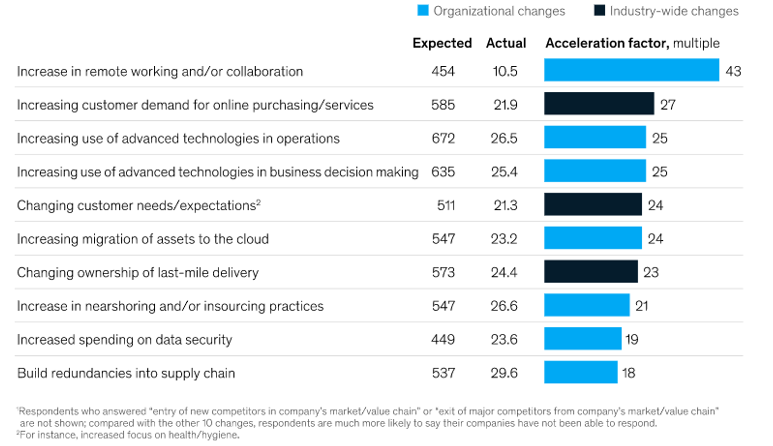The competencies organizations need for successful transformation
In the first article in the series (link), we focused on analyzing which of the key challenges and changes associated with COVID-19 will be long-term, and thus which transformational implementations by companies and brands addressing these challenges will stay with us for the long term. This article, however, will be devoted to the competencies that companies should possess in order to make the transformation a success. In the analysis, we will use data from reports prepared by McKinsey & Company and Gartner.
In the previous article, we compared the current wave of transformation to how doctors address acute medical conditions. In this context, the transformational and technological implementations that have happened over the past year (and are still happening) have resembled quick and decisive physician interventions to stabilize the situation and reduce the severity of the condition.
The chart below shows how severe the interventions were from the company’s perspective. The variable depicting drasticity is the time of introduction, and this has decreased dramatically. Keep in mind that any such implementation comes at a significant cost. For example, remote working, about which far-fetched discussions have been held for years, was, in fact, implemented, and secondly – the implementation took on average about 10 days, compared to 454 (about 43x faster) assumed by experts from the largest companies. Changes in consumer behaviour have also accelerated – a very good example here is the reduction in the time it took consumers to test purchase products online (approx. 22 days, against the assumed 585 days, an acceleration factor of approx. 27).
Figure 1: Time needed to implement changes – assumed vs. actual

Risk aversion the main challenge
Interestingly, when respondents were asked why the above-mentioned implementations did not happen earlier, i.e. before the crisis, they indicated that they were not a business priority and that on a structural level, the lack of clearly defined leadership (and thus clearly defined responsibility) made it difficult to actually implement the changes. Respondents also cited organizational issues as further reasons for the lack of implementation – required changes would be too much of a shock to established ways of working, inadequate technology infrastructure as a potential barrier, organizational silos making it difficult to engage stakeholders. And yet, due to changes in the environment, implementations happened, and much faster than we would have assumed.
Clashing the assumptions of key stakeholders in the largest global companies with the reality of the pandemic indicates quite clearly that the key barrier in implementing transformational implementations is risk aversion. And rightly so – from an executive’s perspective, when deciding on a change that comes with a cost, especially one as significant as the intervention examples above, it is crucial to assess whether the change will translate into positives for the organization. On the other hand, some organizations have embarked on and are implementing transformational solutions successfully, and thus have been able to develop some mechanisms to mitigate risk and enhance decision-making capabilities. What are those mechanisms?
The offensive vs. defensive role of technology in corporate strategy and the role of experimentation and pilot deployments
To be effective, a digital transformation strategy should be understood as a corporate strategy and permeate (incorporate) all of its (the organization’s) elements. In leading companies, digital and corporate strategies are one and the same – the crisis caused by the COVID-19 pandemic has only made this observation more important and urgent than before.
While strong leadership and strategy alignment has always been a key determinant of success during transformation, or disruption (the 2007-2009 funding crisis is a case in point), the extent of the differentiating role of technology and experimentation (pilot deployments) in this regard for the current crisis is clear. Among managers who successfully responded to changes in the environment over the past year, 72% indicated that they were the first in their industry to begin testing new technologies during the crisis, and 67% indicated that they made decisions to invest more in digital solutions relative to their competitors.
Figure 2: The extent and role of technology and experimentation in companies that successfully responded to the COVID-19 crisis

Among companies that have successfully addressed the crisis, an important shift in the perception of the role of technology itself is also evident. While in 2017 about 48% of respondents in the McKinsey survey viewed digital transformation as a source of potential savings (cost function, defensive role), in 2020 only 10% of respondents so defined the role of technological change. In 2020, responses treating technological change as serving to build competitive advantage (38% of respondents), or enabling the modernization of core competencies and leveling the playing field with competitors (30%), were far more common. The key role of digital solutions in reorganizing the entire business was even indicated by 19% of the respondents. Thus, we see that the role of technology and digital solutions in companies that are successfully fighting the current crisis is an offensive role (revenue function).
Figure 3: Perspective on the role of technology in organizations

The next, third article in the series will focus on process recommendations that will bring an organization closer to successfully implementing transformational solutions.


